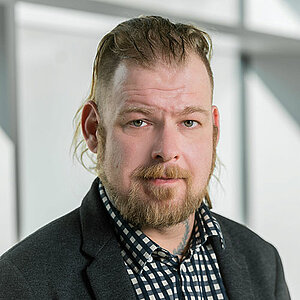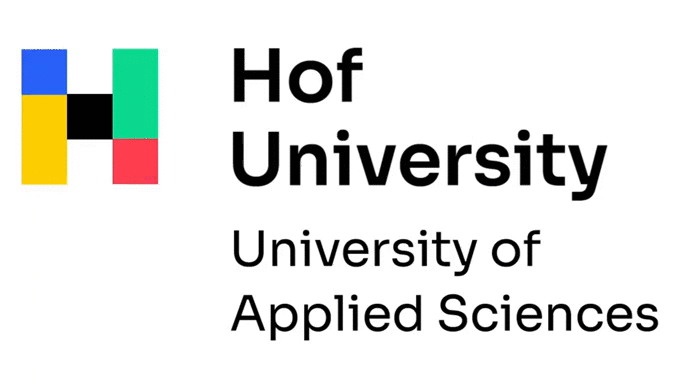
Tobias Schnabel trained as a state-certified CTA for environmental analysis and microbiology and then studied industrial engineering with a focus on energy technology at the Wilhelm Büchner University of Applied Sciences in Darmstadt and water and environment at the Bauhaus University in Weimar. During his many years at the MFPA Weimar, he completed his doctorate externally under Prof. Jörg Londong in the field of urban water management and process engineering for the removal of micropollutants using AOP processes. Since 2022, he has been Professor of Urban Water Resource Management at Hof University of Applied Sciences and heads the “Water and Photonics” research group at the Institute for Sustainable Water Systems and the “Sector Coupling in Environmental Technology” research group at the Institute for Hydrogen and Energy Technology. His research focuses on methods for trace analysis of organic micropollutants, photonic processes for water and wastewater treatment, water sensor technology and a wide range of AOP processes.
Journal Article
Mehling, Simon; Hörnlein, Stefanie; Schnabel, Tobias; Beier, Silvio; Londong, J.rg (2024): Measurement and
thermal characterization of graywater discharge events for house-central collection systems in the context of heat
recovery. Water Reuse. DOI: 10.2166/wrd.2024.054
Cardenas, Nataly; Alarcon, Hugo; Schnabel, Tobias; Mehling, Simon (2024): Synthesis and characterization of
nickel cobaltite–supported film for hexavalent
chromium photocatalytic reduction. Water Science & Technology. DOI: 10.2166/wst.2024.330
Ghiloufi, Mabrouka; Schnabel, Tobias; Mehling, Simon; Kouass, Salah (2024): Investigation of the Effect of Oxide
Additives on the Band Gap
and Photocatalytic Efficiency of TiO2 as a Fixed Film. MDPI Materials 24, 4671 (17). DOI: 10.3390/ma17184671
Cardenas, Nataly; Mehling, Simon; Alarcon, Hugo; Schnabel, Tobias (2024): Visible Light-ActiveCopperCobaltite
Supported Film for
Hexavalent ChromiumPhotocatalytic Reduction. Chemistry Select. DOI: 10.1002/slct.202404596
Schnabel, T., Honke, R., Schmid, A., Mehling, S., Göhring, R., Simek, O., Wolfram, A., Wet-terauer, A., Springer, C. (2023). Low-Cost Test Rig for Characterization of Photocatalytic Pla-nar Materials Using Photonically Sized UV-A LED Light Sources. HardwareX, 16, E00487. doi.org/10.1016/j.ohx.2023.e00487
S. Mehling, T. Schnabel, M. Dutschke,J. Londong. „Floating Immobilized TiO2 Catalyst for the Solar Photocatalytic Treatment of Micro-Pollutants within the Secondary Effluent of Wastewater Treatment Plants“. Water Science and Technology 87, Nr. 5 (1. März 2023): 1082–95. https://doi.org/10.2166/ wst.2023.066.
Mehling, Simon, Tobias Schnabel, and Jörg Londong. 2022. ”Investigation on Energetic Efficiency of Reactor Systems for Oxidation of Micro-Pollutants by Immobilized Active Titanium Dioxide Photocatalysis”, Water 14, no. 17: 2681. https://doi.org/10.3390/w14172681
S. Mehling, T. Schnabel, J. Londong (03/2022):Analysis of the behavior of cumulative analytical parameters and their correlation to micropollutant degradation during treatment of real wastewater bycarrier-bound photocatalytic ozonation. , Water Science and Technology, http://dx.doi.org/10.2166/wst.2022.053
T. Schnabel, M. Dutschke, F. Schütz, C. Springer (02/2022):Photocatalytic Air Purification of Polycyclic
Aromatic Hydrocarbons: Application of a Flow-Through Reactor, Kinetic Studies and Degradation Pathways,
Journal of Photochemistry and Photobiology A Chemistry, https://doi.org/10.1016/j.jphotochem.2022.113993
M. Dutschke,T. Schnabel, F. Schütz, C. Springer (11/2021): Degradation of chlorinated volatile organic
compounds from contaminated ground water using a carrier-bound TiO2/UV/O3-system. , Journal of
Environmental Managment, http://dx.doi.org/10.1016/j.jenvman.2021.114236
T. Schnabel, S. Mehling, M. Dutschke, J. Londong (02/2022): Investigation of factors influencing the
photocatalytic degradation of pharmaceuticals on supported catalysts using UV-A LEDs. , Chemistry
Select, http://dx.doi.org/10.1002/slct.202103759
S. Mehling, T. Schnabel, J. Londong (11/2021): Photocatalytic ozonation in an immersion rotary body reactor
for the removal of micro-pollutants , Water Science and Technology, dx.doi.org/10.2166/wst.2021.617
T. Schnabel, S. Mehling, M. Dutschke, C. Springer (11/2021): Determination of photocatalytic properties of
supported catalysts with low-cost NOx sensors and the Arduino platform , Journal of Photochemistry
and Photobiology A Chemistry, http://dx.doi.org/10.1016/j.jphotochem.2021.113611
M. Scheurer, A. Sandholzer, T. Schnabel, S. Schneider-Werres, M. Schaffer, H. Börnick, S. Beier (09/2021):
Persistent and mobile organic chemicals in water resources: occurrence and removal options for water
utilities , Water Science and Technology, Water Supply, doi: http://dx.doi.10.2166/ws.2021.336
T. Schnabel, S. Mehling, J. Londong, C. Springer (03/2021): Photocatalytic degradation Water containing
Petrol-Derived Hydrocarbons and Methylene Blue using floatable Titanium Dioxide Catalysts , Water
Reuse, http://dx.doi.org/10.2166/wrd.2021.118
T. Schnabel, S. Mehling, J. Londong, C. Springer (10/2020): Hydrogen peroxide-assisted photocatalytic
water treatment for the removal of anthropogenic trace substances from the effluent of wastewater
treatment plants, Water Science and Technology, http://dx.doi.org/10.2166/wst.2020.481
T. Schnabel, C. Springer, K. Krause, S. Hörnlein, J. Londong (08/2020): Spurenstoffelimination aus gereinigtem
Abwasser in einem photokatalytisch wirksamen Rotationstauchkörpers , Korrospondenz Abwasser, Abfall
T. Schnabel, C. Springer, S. Hörnlein, S. Mehling, S. Beier, J. Londong (3/2020): Titandioxid basiertes photokatalytische Material für den Abbau von Pharmaka aus dem Kläranlagenablauf , Gwf AW, 3/2020
M. Bickendorf, T. Schnabel, J. Londong, (3/2020): Die photokatalytische Oxidation als ein Verfahren der weitergehenden Abwasserreinigung , Korrospondenz Abwasser, Abfall
T. Schnabel, D. Martschoke, F. Schütz, (10/2019): Photokatalytische Reinigung von organisch belasteter Innenraumluft am Beispiel von polycyclischen aromatischen Kohlenwasserstoffen (PAK) , Wohnmedizin Zeitschrift
T. Schnabel, D. Martschoke, D. Dressel, K.Krause (3/2018): Pausenlos gute Luft - Naphthalinabbau mit
photokatalytischen Reinigungsverfahren - Teil 2, Bauen im Bestand
T. Schnabel, D. Martschoke (06/2017): Abbauen statt Ausbauen - Naphthalinabbau mit photokatalytischen
Reinigungsverfahren, Bauen im Bestand
T. Schnabel, C. Springer (05/2013): Unter dem Putz auf Spurensuche - GC-MS in der Bauschadensanalytik,
Bauen im Bestand
Contributions to conference proceedings and publication series
Müller-Czygan, Günter; Schnabel, Tobias; Aicher, Andreas; Mehling, Simon (2023): Combination of near-natural
and innovative wastewater treatment as an effective component of sustainable water resource protection in rural
areas. Proceedings of the VІІІ International Scientific and Technical Conference 2023. 2023, S. 32-36.
T. Schnabel: Photokatalytischer Abbau von pharmazeutischen Mikroschadstoffen an trägergebundenen
Katalysatoren. Dissertation, Schriftenreihe Band 41, Bauhaus-Universität Weimar, Fakultät Bauingenieurwesen,
Bauhaus-Institut für zukunftsweisende Infratstruktursysteme (b.is) Coudraystraße 7,
D-99423 Weimar, Rhombos-Verlag Berlin, ISBN: 978-3-944101-82-8, ISSN 1862-1406
T. Schnabel, C. Springe, K. Krause, S. Hörnlein, S. Beier, J. Londong: Spurenstoffelimination aus gereinigtem
Abwasser mittels photokatalytisch wirksamen Rotationstauchkörpern. GWA Band 252 zur
Essener Tagung 2020, ISBN: 978-3-938996-58-4
Lectures
T. Schnabel: Entfernung von Mikroverunreinigungen an trägergebundenen Photokatalysatoren, 55. Essener
Tagung, young scientists Forum (03/2022), Essen, Vortrag
T. Schnabel,S. Beier, J. Londong: Entfernung von Mikroverunreinigungen aus Abwasser mit trägergebundenen
Photokatalysatoren, SIMAS Erfahrungsaustausch (10/2019), Seelscheid, Vortrag
Beier, S.; Börmel, M.; Gröber, C.; Schnabel, T.; Londong, J.; Klümper, C. 2019. Kunststoffeinträge im
Bereich der Siedlungswasserwirtschaft. Thüringer Umwelttag der IHK, 25.09.2019, IHK Erfurt.
T. Schnabel: Photocatalytic Air and Water treatment, Porotec Tagung (11/2018), Wiesbaden Niedernhausen,
Tagungsbandbeitrag, Vortrag
T. Schnabel: Photokatalytische Wasser und Luftreinigung, Thüringer Werkstofftage (3/2018), Weimar,
Tandemvortrag mit der Firma Lynatox GmbH,
T. Schnabel: HPLC und LC-MS in der photokatalyse Forschung (3/2017), Leipzig, Thermo Anwendertreffen
Vortrag
Wätzel, T.; Krause, K.; Schnabel, T. (2016) Measurement of human-dispensed pharmaceuticals in complex
matrices, like digestates and blackwater. In: Proceedings 18th EWA International Symposium
”Challenges arising from Micro-Pollutants in Wastewater, Water, and Environment”. Munich, May.
Scientific Poster
Cardenas, Nataly; Alarcon, Hugo; Mehling, Simon; Schnabel, Tobias (2024): SYNTHESIS AND
CHARACTERIZATION OF NICKEL COBALTITE
SUPPORTED FILM FOR HEXAVALENT CHROMIUM
PHOTOCATALYTIC REDUCTION. Pro Ciencia. DOI: 10.13140/RG.2.2.32665.74085
Schnabel, Tobias; Faghih Nasiri, Elaheh; Mehling, Simon (2024): Photoelektrochemische Zellen zur simultanen
Energieerzeugung und Schadstoffentfrachtung. Hofer Energiesymposium 2024, Hof. DOI:
:10.13140/RG.2.2.14001.60004
Cardenas, Nataly; Alarcon, Hugo; Mehling, Simon; Schnabel, Tobias (2024): S.NTESIS Y CARACTERIZACI.N DE
PELICULA SOPORTADA DE COBALTITA DE
N.QUEL PARA FOTO-REDUCCI.N DE CROMO HEXAVALENTE. II Congreso Nacional de Semilleros de
Investigaci.nII CONASEIN. DOI: 10.13140/RG.2.2.20220.45443
Martschoke, Daniel; Schnabel, Tobias; Kühmstedt, Michael (2024): Photokatalytische Luftreinigung. PhoTech
Tagung 2024, Weimar. DOI: :10.13140/RG.2.2.14957.19686
Mehling, Simon; Wolfram, Axel; Schnabel, Tobias (2024): Herstellung von TiO2 -Photokatalysatoren via
Sol-Gel basiertem Dip-Coating. PhoTech Konferenz, Weimar 2024. DOI: :10.13140/RG.2.2.35089.85602
Isler, Edgar; Dutschke, Manuel; Kleemann, Susanne; Wetterauer, Andre; Rädlein, Edda; Schnabel, Tobias;
Springer, Christian (2024): Untersuchungen der Adsorptivität und Reaktivität von
schwimmf.higen Titandioxid-Katalysatoren. Thüringer Werkstofftage 2024, Weimar. DOI :10.13140/RG.2.2.29595.27683
Dutschke, Manuel; Wetterauer, Andr.; Kleemann, Susanne; Schnabel, Tobias; Springer, Christian (2024): Abbau
von Mineralölbelastungen auf Wasseroberflächen
durch photokatalytisch beschichtete Schwimmkörper. Thüringer Werkstofftage 2024, Weimar. DOI:10.13140/RG.2.2.32950.72008
T. Schnabel: Photocatalytic Air and Water treatment, Porotec Tagung (11/2018), Wiesbaden Niedernhausen,
Tagungsbandbeitrag, Poster
T. Schnabel: Photokatalytische Wasser und Luftreinigung, Thüringer Werkstofftage (3/2018), Weimar,
Poster
S. Mehling;M. Dutschke; A. Wetterauer; C. Telle; K. Heimler; T. Schnabel; C. Springer; C. Vogt; J. Londong:
Abbau von Mikroschadstoffen an schwimmfähigen Photokatalysatoren durch solare Strahlung, DWA
Landestagung Thüringen, 09/2022, Poster
Prof. Schnabel teaches mainly in the Bachelor of Engineering and the Master of Sustainable Water Engineering and Management.
The following courses are offered
- Ecotoxicology
- Environmental Analysis
- Water extraction and treatment
- Advanced Water Treatment (Master)
- Integrated Water Resources Management (Master)
- Water and Society (Master)
- Hydrology and Hydrogeology
- New Technologies in the Water Sector (Master)
- Environmental Chemistry
The “Photonics and Water” working group is currently working on the following research projects
CataVolt (Abgeschlossen) https://forschung.hof-university.de/de/forschungsprojekt/6-catavolt
UV-Phon https://forschung.hof-university.de/de/forschungsprojekt/15-uvphon
RUBIN-Photech. https://forschung.hof-university.de/de/forschungsprojekt/50-rubin-photech
EULe - DBU

18/03/2018 Second place in the poster competition of the Thuringian Materials Day, Weimar
29/09/2021 Applied Photonics Award, category best dissertation, of the Fraunhofer IOS Jena,
Awarded by Prof. Andreas Tünnermann and Reinhard Genzel https://www.youtube.com/watch?v=txfvWtN3koA
07/02/2022 Semifinalist in the Ocean Optics grand program
Topics for Student Theses in Cooperation with DLR
As part of the DLR project C.R.O.P.®, recycling technologies are being developed for use in biological life support systems to enable long-term human stays on the Moon or Mars. The core of these developments is the C.R.O.P.® process, which processes nitrogen-containing waste, such as human urine, into fertilizer for food cultivation. The project also includes technology transfer from space research to agriculture. This area focuses on processing liquid manure into a plant-available fertilizer solution. The C.R.O.P.® process, originally developed for space applications, is being adapted to the challenges of agriculture.
Topic 1: Multivariate Data Analysis for Online Analytics of C.R.O.P.® Influent and Effluent Using Online UV-VIS Spectroscopy
This thesis focuses on analyzing UV-VIS spectra measured online to correlate wastewater parameters such as nitrate, nitrite, ammonium, COD, and DOC with UV-VIS spectra. A matrix-based calibration of these parameters will be developed for the control of the C.R.O.P.® system. The thesis also includes statistical data collection on laboratory analytical target parameters such as detection and quantification limits, as well as the optimization of the measurement system concerning the sample matrix.
Topic 2: Treatment of C.R.O.P.® Effluent Using Photocatalysis and Electro-Photocatalysis with High-Intensity Artificial UV-A Light
For advanced treatment of C.R.O.P.® effluent, a photocatalytic microreactor with very high UV intensity will be used. A process parameter analysis will be conducted for the mathematical optimization of the procedure. Key parameters include radiation intensity, residence time, and electrochemical parameters such as voltage and current. The treated urine matrix will be chemically analyzed post-treatment for organic micropollutants (xenobiotics) and conventional chemical parameters such as COD, DOC, and nitrogen species. The goal is to design a compact treatment system based on the collected measurement data from the small-scale reactor.
Topic 3: Development and Testing of a Photocatalytic System for Treating Urine Substrates Using Sunlight to Reduce Organic Load and Xenobiotic Compounds
The aim of this thesis is to develop a solar-powered process system for treating urine substrates through photocatalysis. Reaction rates will be correlated with solar radiation intensity to enable system control based on hydraulic residence time. Design approaches for larger-scale systems will be derived and justified using the collected data.
Contact:
Prof. Dr. Tobias Schnabel - Tobias.schnabel@hof-university.de
Dr. Gerhild Bornemann - gerhild.bornemann(at)dlr.de
Additional Topics
Bachelor’s Theses
- Literature review on thermal utilization of wastewater and wastewater substreams. Development of an evaluation matrix for the state of the art and recommendations for further technological advancements.
- Energetic comparison of AOP processes based on literature values from research. Development of scale-up models with technical and economic target parameters to assess the future economic viability of different processes.
Master’s Theses
- Experimental determination of the band gap shift on titanium dioxide catalysts using dyes in wastewater treatment. Initial experiments for developing "artificial photosynthesis" as an energy-neutral system for micropollutant removal.
- Activity determination of different photocatalyst coatings through adapted measurement regimes, incorporating the modeling of LED UV arrays to be used. Development of small-scale coating technologies.
